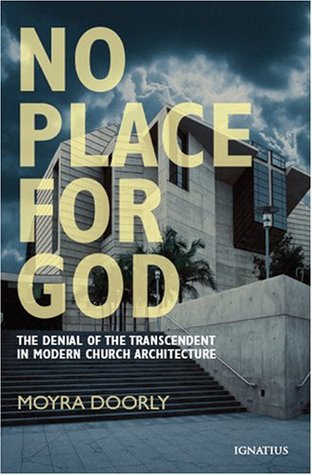On being taken to Mass in the underground basilica at Lourdes, the late Msgr. Alfred Gilbey, that most courteous of men, was moved to comment, “It reminds me of nothing so much as a Nazi rally.” He was referring to the vast crowds, the raised central stage, and the spotlit altar of this concrete bunker. Moyra Doorly, an architect and convert, does not use so extreme an image in her analysis of modern church architecture, but she makes her views very plain. Modern churches, she believes, are geared “to the celebration of . . . the worshipping community,” not to a transcendent God; they are temples to the “spirit of the age,” and, just like earlier styles such as Gothic and Baroque, they reflect the theology of their times.
This theology, the author argues, is infected by modernism. Creeping in under the coattails of “the spirit of Vatican II” and in various disguises, modernism’s impact on church design has been profoundly destructive. It has introduced the concept of “relativist space,” directionless and nonhierarchical, deliberately blurring the distinction between nave and sanctuary—and consequently, the distinction between priest and people. Where no part of the church is more significant than any other, sacred space ceases to exist. So altar rails are removed, chairs replace pews, and the congregation gathers round in an informal assembly.
Behind this “re-ordering”—a weasel word that must have caused alarm and sorrow in the hearts of many parishioners who have seen beloved parish churches altered beyond recognition—have been the postconciliar changes to the liturgy. For Doorly, there is a symbiotic relationship between the new, or Ordinary, Rite of Mass and modern church architecture. “New church building is required for a new liturgy” has been the mantra. In order to accommodate Mass said facing the people, altars have been rearranged and tabernacles removed to inconspicuous places in the church. This destabilization of the sanctuary has led to the destabilization of all other areas in the church; and when Mass is no longer said ad orientem (facing the east), it has led to the disorientation of the congregation, lost in empty, uninspiring, homogeneous spaces.
Doorly makes a strong plea for the priest to face east, at least symbolically, for the liturgy of the Eucharist and in particular the canon, believing that this would better emphasize the transcendent nature of the Mass. While readers may not agree with her contention that the long arm of modernism, influenced by Le Corbusier, Darwin, and other secular elements, is behind the reordering of existing churches and the building of new ones, it is impossible not to agree with her verdict: “the ugliest churches in history.” Made of steel and reinforced concrete, with exposed brickwork and bare of ornamentation (especially statues), with abstract imagery and severe geometry, painted in flat, neutral colors under flat roofs, with soft carpeting and potted plants, such buildings are more like conference halls than churches.
Doorly quotes the liturgist Msgr. Klaus Gamber: Modern churches are not “houses of God in the true sense. . . . they are meeting facilities, places nobody wants to visit except when services are being conducted.” This is a grave indictment. Just as past converts remarked on the palpable presence of God upon entering Catholic churches, today, there is often an echoing sense of His absence. Doorly includes many graphic photographs to illustrate her thesis. These include Clifton and Los Angeles cathedrals—the former looking suitable for seminars; the latter, for concerts—the barn-like, open-plan Chapel of Reconciliation at Walsingham, and the church of St. Joseph’s, Bunhill Row, London, which was reordered in the 1970’s, restored to something of its former beauty in the 1990’s, and then reordered again in 2003 in the depressingly familiar modern style.
Of course, not all modern churches are modernist, either in conception or execution. Our own church in Long Crendon, Buckinghamshire, built in 1971 and known as “the gem of the Chilterns,” is instantly apprehended as a house of God; its stone calvary, in which the tabernacle is embedded, and altar (modeled on that of the French church at Leicester Square) are positioned in a sanctuary that is the magnetic focus of the church. Yet all too many churches demonstrate Doorly’s conviction that, in the last 40 years, we have somehow replaced the worship of God with the comfort and complacency of the community.
Reading this volume, slim in size but passionate in argument, reminded me what churches are for: the celebration of Mass and the abiding presence of God. They are thereby hallowed in their association with the Divine. That is why we visit them outside Mass times: to raise our minds and hearts beyond the material to what is mysterious, ineffable—and beautiful. Modern church architects too often forget that God is beauty—“Beauty at once so ancient and so new,” as Saint Augustine exclaimed on his conversion. In obliterating the sacred, they have only succeeded in replacing it with the boring and the banal.
Gothic cathedrals, built without modern technology, have stood for several hundred years as magnificent testaments of faith. Even the Lady Chapel at Ely Cathedral, its statues disfigured by the Puritans, still conveys a sense of the delicate radiance of its conception. In contrast, modern churches crack, buckle, rust, and leak within decades of being built. What will our descendants make of our perverse, puritanical wish to replace sacredness and beauty with a drab severity? The motto of St. Pius X is relevant here: Instaurare Omnia in Christo, “To restore all things in Christ.” The Latin word instaurare implies both renewal and restoration. The book’s message is clear. It should be read by all who care about our worship. If we want renewal of faith, we must cease to reorder—and begin to restore.
[No Place for God: The Denial of the Transcendent in Modern Church Architecture, by Moyra Doorly (San Francisco: Ignatius Press) 160 pp., $14.95]

Leave a Reply